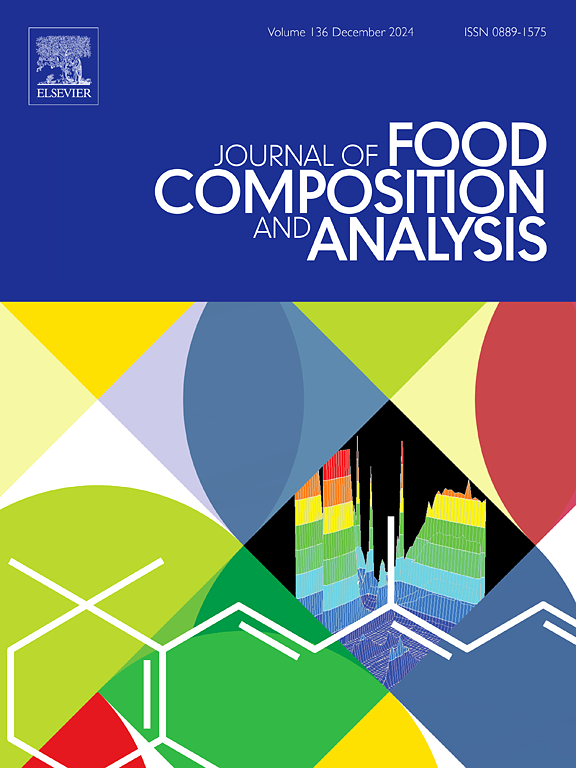Application of GO@ZIF-8 MOF/molecularly imprinted polymer composite for multiple monolithic fiber solid phase microextraction: Determination of illegally added amphetamines in snacks and beverages and quantitation by GC-MS
IF 4
2区 农林科学
Q2 CHEMISTRY, APPLIED
引用次数: 0
Abstract
Some adulterated products are marketed to promote weight loss, increase energy or cognition, build muscle, or promote athletic and sexual performance. They may contain undisclosed or mislabeled substances. In this study, a new method for the determination of amphetamine derivatives illegally added to beverages and snacks using a GO@ZIF-8 MOF fiber combined with molecularly imprinted polymer (MIP)/solid-phase microextraction (SPME), followed by gas chromatography-mass spectrometry (GC-MS) analysis is presented. The prepared fiber is characterized by Fourier-transform infrared (FT-IR), X-ray powder diffraction (XRD), and scanning electronic microscope (SEM) techniques. Following optimization of the extraction factors, a linear range between 0.1 and 400 μg L−1 with a coefficient of determination (R2) exceeding 0.9976 was achieved for the specified compounds. Detection limits for amphetamine derivatives were found to be between 0.023 and 0.033 μg L−1. The limits of detection were found to comply with regulatory limits, indicating the sensitivity of the method for routine analysis. This method was effectively utilized to quantify amphetamine derivatives in snakes and beverages samples. The recovery rate exceeded 96.2 %, and the error under 6.7 %, demonstrating the reliability of method. No significant interference from sample matrix components was observed, demonstrating the selectivity of the method.
GO@ZIF-8 MOF/分子印迹聚合物复合材料在多层整体纤维固相微萃取中的应用利用气相色谱-质谱法测定零食和饮料中非法添加的苯丙胺类药物并定量
一些掺假产品的营销目的是促进减肥、增加能量或认知能力、增强肌肉或提高运动和性能力。这些产品可能含有未披露或贴错标签的物质。本研究提出了一种新方法,利用 GO@ZIF-8 MOF 纤维结合分子印迹聚合物 (MIP) / 固相微萃取 (SPME),然后进行气相色谱-质谱 (GC-MS) 分析,测定饮料和零食中非法添加的苯丙胺衍生物。傅立叶变换红外(FT-IR)、X 射线粉末衍射(XRD)和扫描电子显微镜(SEM)技术对制备的纤维进行了表征。优化萃取因子后,特定化合物的线性范围为 0.1 至 400 μg L-1,测定系数 (R2) 超过 0.9976。苯丙胺衍生物的检测限为 0.023 至 0.033 μg L-1。检测限符合法规要求,表明该方法在常规分析中的灵敏度较高。该方法可有效地定量检测蛇类和饮料样品中的苯丙胺衍生物。回收率超过96.2%,误差小于6.7%,证明了该方法的可靠性。没有发现样品基质成分的明显干扰,证明了该方法的选择性。
本文章由计算机程序翻译,如有差异,请以英文原文为准。
求助全文
约1分钟内获得全文
求助全文
来源期刊

Journal of Food Composition and Analysis
工程技术-食品科技
CiteScore
6.20
自引率
11.60%
发文量
601
审稿时长
53 days
期刊介绍:
The Journal of Food Composition and Analysis publishes manuscripts on scientific aspects of data on the chemical composition of human foods, with particular emphasis on actual data on composition of foods; analytical methods; studies on the manipulation, storage, distribution and use of food composition data; and studies on the statistics, use and distribution of such data and data systems. The Journal''s basis is nutrient composition, with increasing emphasis on bioactive non-nutrient and anti-nutrient components. Papers must provide sufficient description of the food samples, analytical methods, quality control procedures and statistical treatments of the data to permit the end users of the food composition data to evaluate the appropriateness of such data in their projects.
The Journal does not publish papers on: microbiological compounds; sensory quality; aromatics/volatiles in food and wine; essential oils; organoleptic characteristics of food; physical properties; or clinical papers and pharmacology-related papers.
 求助内容:
求助内容: 应助结果提醒方式:
应助结果提醒方式:


